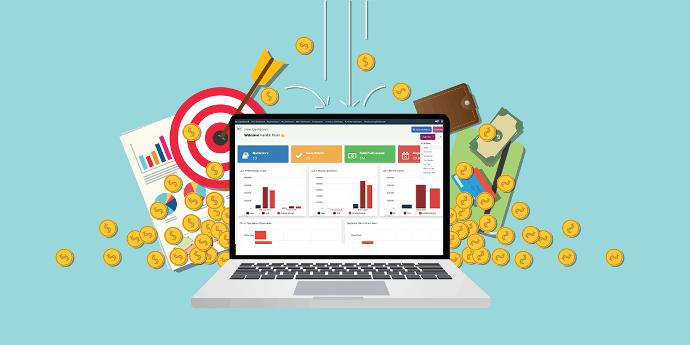Do You Know, How Much You Can Save After Implementing Manufacturing ERP Software with Lean and Six Sigma into Your Manufacturing Business?
In the highly competitive environment of modern manufacturing, efficiency is not just a goal—it's a necessity. Every resource must be utilized optimally to keep costs down and productivity high. This is where the powerful combination of manufacturing ERP software, Lean, and Six Sigma comes into play. Together, these tools and methodologies can revolutionize your manufacturing processes and lead to significant savings. But just how much can you save? Let's dive into the transformative benefits and tangible cost reductions you can achieve.
Understanding the Trio
(1) ERP Software:
ERP systems are comprehensive platforms that integrate core business processes such as finance, HR, inventory management, procurement, and production planning into a single, unified system. They provide real-time data, facilitate collaboration, and automate tasks, leading to increased efficiency and better decision-making.
(2) Lean Methodology:
The main goals of the lean methodology are process improvement and waste elimination. This lean management methodology emphasizes continuous improvement, customer value, and employee empowerment. By identifying and eliminating non-value-added activities, Lean aims to create a more efficient and responsive workflow.
(3) Six Sigma:
Six Sigma is a data-driven process improvement methodology that aims to lower differences and failures. It employs statistical analysis and structured problem-solving methodologies like DMAIC (Define, Measure, Analyze, Improve, Control) to identify root causes of problems and implement solutions that lead to consistent quality and performance.
Don't Just Read About Success,
Take the Next Step
Let's Schedule a Consultation Meeting
Quantifying the Savings
(1) Reduced Inventory Costs:
By integrating ERP software with lean management, manufacturers can implement just-in-time inventory management. This approach minimizes excess inventory, reduces carrying costs, and frees up capital for strategic investments. Savings in inventory costs can range from 20% to 40%.
(2) Optimized Production Planning:
Manufacturing ERP software with lean management and Six Sigma methodologies capabilities enables efficient production scheduling based on real-time demand signals, inventory levels, and production capacities. This leads to optimized resource utilization, minimized downtime, and up to 30% savings in production costs.
(3) Improved Quality Control:
Six Sigma methodologies integrated into manufacturing ERP software empower manufacturers to identify and address quality issues proactively. By reducing defects and rework, businesses can achieve a 25% to 50% decrease in quality-related costs.
(4) Streamlined Supply Chain:
ERP solutions facilitate end-to-end visibility across the supply chain, from procurement to delivery. By optimizing supplier relationships, lead times, and transportation costs, businesses can realize savings of 15% to 30% in supply chain expenses.

Case Study: Transforming Savings into Profit
Let's consider a hypothetical case study of a manufacturing company that implemented ERP software integrated with Lean and Six Sigma methodologies:
Feedchem Inc. company saw significant improvements in its operations after adopting this integrated approach:
Inventory Reduction: Reduced excess inventory by 30%, saving 150,000 annually in storage costs.
Labor Efficiency: Optimized workforce utilization led to a 15% reduction in labor costs, amounting to 300,000 in savings per year.
Maintenance Downtime: Minimized equipment downtime by 20%, saving 150,000 annually in maintenance and repair expenses.
Procurement Savings: Streamlined procurement processes resulted in 100,000 in savings through better supplier negotiations and reduced lead times.
Quality Enhancements: Reduced defects by 25%, saving 100,000 in rework costs and warranty claims.
Potential Savings Breakdown
- Operational Cost Savings: 10% - 30%
- Inventory Reduction: 20% - 40%
- Productivity Increase: 20% - 50%
- Quality Improvement: 20% - 50%
These estimates can be used as a benchmark, but for a more accurate prediction, a detailed assessment of the specific business processes and current performance metrics is essential.
Read Also: Lean-Based ERP: Improve Business Performance with a Lean Manufacturing System
Conclusion: A Roadmap to Savings and Success
Implementing Manufacturing ERP Software with Lean and Six Sigma methodologies in your manufacturing business can lead to substantial cost savings and operational improvements. From reducing production costs and inventory levels to improving quality and employee productivity, the financial benefits are significant. By strategically implementing these tools and fostering a culture of continuous improvement, manufacturers can achieve lasting competitive advantage and drive sustainable growth.
Guidebook for Common Queries
(1) What role does Lean play in cost savings?
Answer: Lean principles focus on minimizing waste, optimizing processes, and eliminating non-value-added activities, resulting in improved productivity, reduced inventory costs, and enhanced operational efficiency.
(2) What role does an ERP consultant play in implementing Manufacturing ERP software with Lean and Six Sigma?
Answer: An ERP consultant brings expertise in both Manufacturing ERP software and Lean/Six Sigma methodologies. They help businesses assess their current processes, design customized solutions, train employees, and ensure smooth implementation and continuous improvement.
customized ERP software, lean manufacturing, best manufacturing ERP software, lean in manufacturing industry, lean management production, lean six sigma, six sigma in operations management, six sigma in manufacturing industry, manufacturing ERP software, ERP for manufacturing company,
six sigma in operations management,
six sigma in manufacturing industry
customized ERP software, lean manufacturing, best manufacturing ERP software, lean in manufacturing industry, lean management production, lean six sigma, six sigma in operations management, six sigma in manufacturing industry, manufacturing ERP software, ERP for manufacturing company,
six sigma in operations management,
six sigma in manufacturing industry
Don't Wait for the Right Time,
Let's Talk & Implement it
Let's Schedule a Consultation Meeting